
Biotricity
Crossing the Chasm
By Gergana Koleva
Biotricity's disruptive remote monitoring technology platform and solutions are geared towards tackling cardiovascular disease. CEO Waqaas Al-Siddiq is all set to execute legendary management consultant Geoffrey Moore’s strategy on market diversification: advancing the platform capabilities to fight other chronic medical conditions.
Biotricity has built a remote patient monitoring platform comprised of three key components tailored to a variety of diagnostic and post-diagnostic applications. The first two applications of this platform cover the diagnostic and post-diagnostic cardiac markets: Bioflux® and Biocentrix.
Innovating upstream
Biotricity is a California-based biosignal monitoring company that wants to ease the triple burden of cost, treatment adherence, and logistics associated with chronic disease management, starting with the cardiovascular disease market. It has developed a range of solutions that tackle this burden upstream by harnessing data and triggering alerts about potential complications before they occur. Strategically, the company focuses on a segment of a person´s health journey that appears to be a blind spot for most players in the medtech and lifestyle wearables ecosystem: diagnostic and post-diagnostic remote monitoring for primary and secondary prevention.
Biotricity´s first use case is detecting the presence of cardiovascular disease, which often begins with a slow-building, silent set of symptoms that many people miss or don’t have diagnosed until a critical event happens. In 2018, to monitor patients with suspected cardiopathy, the company brought to market its flagship mobile cardiac telemetry (MCT) device Bioflux®, which consists of a mobile electrocardiogram (ECG) monitoring unit worn by the patient and a viewer software package that visualizes the data. The device tracks and transmits real-time, clinical-grade data about users´ heart status to a HIPAA-compliant cloud framework, accessible at the company´s 24/7 center by certified cardiography technicians who liaise with patients´ doctors and activate an emergency response in case of an anomaly. This enables physician practices and clinicians who purchase the devices to bill insurance directly and assign them for temporary use to their ambulatory patients to get access to uniquely granular time series information that can aid in the diagnosis of multiple heart conditions at an early stage, before symptoms deteriorate or even manifest ostensibly.
Late last year, the company completed development of another ECG monitoring device, the rechargeable Biotres, which delivers a miniaturized version of the Bioflux® technology in an even more user-friendly format. Using three electrodes and no lead wires, its aim is to monitor patients at lower cardiac risk or with less complicated conditions. It also employs the same diagnostic and similar wireless communication capabilities as Bioflux®, while allowing for maximum signal conduction due to its patch format.



REMOTE PATIENT MONITORING
THE REVOLUTION OF

The device tracks and transmits real-time, clinical-grade data about users´ heart status to a HIPAA-compliant cloud framework, accessible at the company´s 24/7 center by certified cardiography technicians who liaise with patients´ doctors and activate an emergency response in case of an anomaly.
Taking The Long View
At the vanguard of remote monitoring
“Much of the U.S. is still stuck in passive Holter recording versus real-time active monitoring. Passive recording collects data but the data has to be downloaded for analysis [whereas] active monitoring is transmitting whenever the device detects an issue… And then you still have legacy providers that are using manual methods to perform cardiac diagnostics. Long term, these guys will disappear,” says Waqaas Al-Siddiq, Biotricity´s founder and CEO, in comparing the company´s approach to that of traditional ECG monitoring methods.
“Our algorithms detect the key arrhythmias – atrial fibrillation, atrial flutter, tachycardia – and then subclassify them into specific categories such as atrial or ventricular issues. They also calculate how often this occurs to let a physician understand what percent of the time a patient is having [an] arrhythmia. Whenever we detect an arrhythmia, Bioflux® determines the severity in real-time based on [physician-customized] settings and transmits the data.”
Al-Siddiq, who has a background in wireless and sensor networks – before founding Biotricity in 2014 he was Chief Technology Officer of Toronto-based Sensor Mobility – places a strong emphasis on the intrinsic mechanics of the products his company offers. He sees a qualitative leap ahead in the capacity for predictive analytics that user-centered technology, designed to capture even the smallest variations, can make. As an avid polo player, he says the sport has sharpened his intuition for noticing and responding to “little variables” while playing really fast, and he exhibits the restless drive of an innovator who foresees where the future is headed and wants Biotricity to be there first.
“Our culture is driven by looking at what the product will be ten years from now and then dialing that back to what base features we need to focus on to achieve that,” he says in explaining the design process behind Bioflux®. “We knew we wanted to create a diagnostic-quality ECG that has no electrodes. That meant there would be a lot of motion artifact and that drove us to focus on motion algorithms and integrate an accelerometer and gyro technology in our first generation. We are always thinking about what we can do today and what we need to experiment with for tomorrow, and then try to build and innovate based on that.”

Polo is a hobby of mine. I play quite regularly. I think it serves as a great analogy as you are playing really fast with a lot of little variables going on and you have to be aware of so many things to play effectively. Healthcare technology is like that…it is a complex industry with layers… and you can go fast but you have to know what you are doing. It is about going fast but being aware and in control.
Market strategy
Grounded in the conviction that it is headed in the right direction, just three years after its founding, Biotricity went public in 2017 (OTC.QB:BTCY). A key element of its business model is the compatibility of its biosignal monitoring technology with existing electronic health records systems, so that customers can apply reimbursement codes from the get-go. This is another facet, in addition to its dynamic real-time telemetry technology, that the company has designed well and that differentiates it from many start-ups in the medtech economy that still bring to market solutions without a clear revenue model.
Yet another strategic choice that gives Biotricity an edge in the medtech space is its platform´s adaptability to different therapeutic areas and market segments. Although it is betting strongly on solutions for cardiac arrhythmia detection with Bioflux® and a complementary post-diagnosis device for personal wellness monitoring called Biocentrix, the company plans to expand to other medical indications where preventive monitoring can have a significant impact, such as COPD, sleep apnea, and fetal and maternal monitoring.
“Other medical device companies are focused on singular markets, so there´ll be just a cardiac or just a diabetes company or just a sleep apnea company… We´ve built a platform where by changing around the sensor and repackaging things, we can actually move markets. So as a company we can bring a broader suite of solutions to the market and go more horizontally as opposed to vertically,” says Al-Siddiq.
Last but not least, and perhaps just as important as the space in which Biotricity is making a difference, it is worth nothing where the start-up is not competing: the consumer wearable ECG market. This includes a vast pool of up to 50 device companies offering non-clinically validated and non-reimbursable personal use units.

Having situated itself at the advanced end of the market for cardiac telemetry and remote monitoring, Biotricity is a fascinating prism through which to view one of the most exciting directions in which healthcare innovation is headed: the intersection of digital therapeutics and data analytics. This is not only due to its imaginative, highly intuitive design and technologies today.
“Five to ten years from now I think we will be experimenting with very different things. Implants for sure, but more than that, growing organs, being able to augment organs with sensors and tech than can help improve their function. Think of an implantable defibrillator but far more sophisticated [than what we have today], where it is helping to fix an underlying issue as opposed to just shocking you back to normal sinus,” says Al-Siddiq. “We are going to move into fixing the underlying issues as opposed to treating the problem.”
Clinical-grade telemetry, motion-based algorithms, bold innovation compatible with legacy systems, and a daring leap in the sometimes overlooked preventive health segment. These are some of the major aspects and strategic decisions that Biotricity has capitalized on so well, so far. The company is undoubtedly an exciting player in the biometric remote monitoring space to watch. But above and beyond the interplay of sophisticated technology and smart commercialization strategy, there is a simple objective that just might be its greatest value proposition: to serve as a bridge between the healthcare system and the people it treats.
